24 Dog Breeds That Can Live Outside (Or At Least Enjoy It)
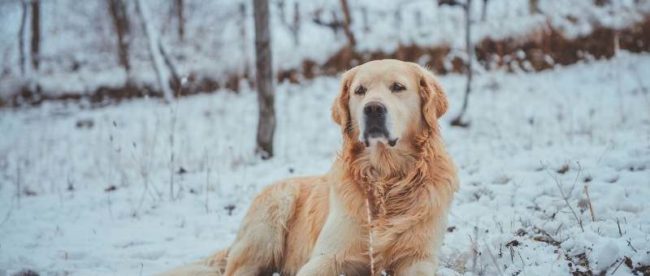
Dogs make excellent pets, and most breeds can live happily in the home. However, this may not always be possible. Some owners choose to have work dogs who live outside, but others may need to keep their dogs at a safe distance owing to allergies. Depending on the temperature, it may be best to let your dog bask in the sun and stars all day. Certain breeds are more adapted to outdoor living because of their physical make-up and disposition, and they like hanging out outside. The pups from the following list are significantly happier when they have their own outdoor living space and overall are great dog breeds that can live outside or at least enjoy spending time outside.
Do you have a specific question about the subject? Then use the table of contents below to jump to the most relevant section. And you can always go back by clicking on the black arrow in the right bottom corner of the page. Also, please note that some of the links in this article may be affiliate links. For more details, check the Disclosure section at the bottom of the page.
Here's what we'll cover:
- Akita
- Alaskan Malamute
- American Foxhound
- Anatolian Shepherd
- Australian Cattle Dog
- Australian Shepherd
- Bearded Collie
- Belgian Sheepdog
- Bernese Mountain Dog
- Border Collie
- German Shepherd
- Great Pyrenees
- Greater Swiss Mountain Dog
- Irish Wolfhound
- Labrador Retriever
- Mastiff
- Norwegian Elkhound
- Rhodesian Ridgeback
- Rottweiler
- Samoyed
- Siberian Husky
- Shiba Inu
- Vizsla
- Weimaraner
Akita
The Akita is a gorgeous working breed from Japan that can occasionally weigh more than 100 pounds. His big size is matched by a stubborn streak, so he is not the dog for a new owner.
Despite his size, he requires low activity, with a daily walk sufficing. His thick fur keeps him warm in the snow, but he can overheat if left outside in the sun.
He loses this fur seasonally, which may be somewhat thick, so be prepared for epic hair tumbles around the house or patio.
Akitas must be socialized and trained early to avoid people and animal conflict because they are naturally distant and protective. With this in mind, he should never be left alone for long periods, as he is happiest when surrounded by his people.
Alaskan Malamute
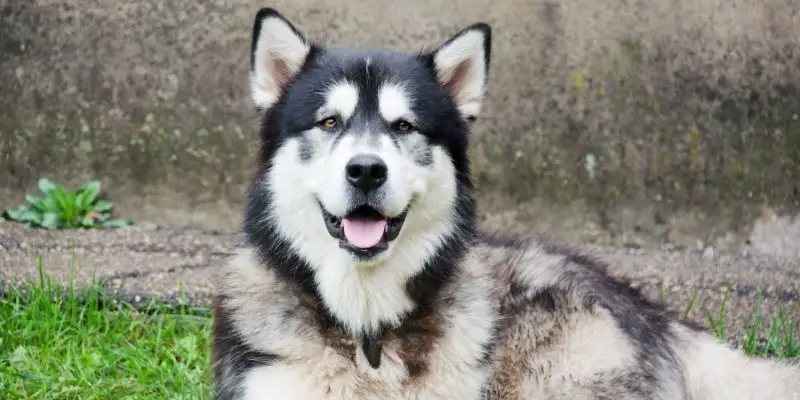
Alaskan Malamutes, which weigh 75-85 pounds as adults, were bred to pull heavy loads by sled through snowy terrain. The dense fur of these strong, faithful dogs keeps them warm in inclement weather. Malamutes might be stubborn, but they are also bright and hardworking.
American Foxhound
American Foxhounds were developed for speed and are best suited to rural settings with plenty of open space. Because of their stamina, these cheerful dogs make excellent jogging companions. Adults weigh between 40 and 65 pounds. Experienced pet owners advocate teaching your American Foxhound when it is young for the best results.
Anatolian Shepherd
This strong livestock guardian rules over his flock. The Anatolian is a rough breed that can handle himself.
He is naturally aloof and may become overprotective if not socialized at a young age. As a result, he should not be left alone for extended periods.
His size and independence make him difficult to train, so he’s not the dog for someone looking for their first puppy. However, early and continuous training is essential for producing a well-rounded Anatolian.
The Anatolian’s dense coat protects him from the weather and just needs to be brushed once a week to keep it looking wonderful.
He sheds significantly twice a year, but aside from that, he’s minimal maintenance in terms of grooming. Despite his size, he only requires moderate activity, with a long daily stroll usually sufficing.
Australian Cattle Dog
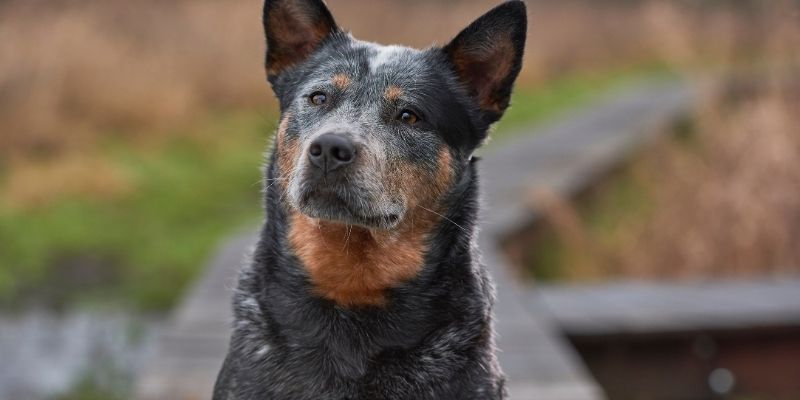
The Australian cattle dog is a tireless worker who enjoys a good run around the pasture, making him an excellent choice for an outdoor dog.
He’s naturally scrappy and can be reserved around new people, so make early socialization with people and animals a priority. And while the cattle dog is intelligent, he isn’t always keen on listening. As a result, he’s not the best choice for a first-time dog owner.
Cattle dogs have a double coat ideal for outdoor experiences, and they only need grooming when he gets dirty. He does, however, shed consistently.
He needs daily exercise to be happy. A doggie activity like agility is strongly advised if he isn’t actively working cattle or performing another work-like task.
Australian Shepherd
Australian Shepherd Dogs were bred as livestock guardians and are known as the cowboy’s preferred herding dog. These dogs, known as Aussies, thrive in agility competitions and make excellent hiking or running buddies. However, these 35-70-pound canines require a lot of exercises to stay happy.
Bearded Collie
Bearded Collies were initially bred as cattle herding dogs because of their intelligence and agility. These hairy dogs, weighing 35 to 60 pounds, require regular care because of their lengthy coat. However, bearded Collies can be entertaining household pets.
Belgian Sheepdog
Belgian Sheepdogs are agile and obedient and are known for being easy to train. Their superior tracking abilities make them indispensable members of search and rescue teams. Unfortunately, these characteristics give them a strong prey drive, meaning they will chase almost anything that moves. Belgian Sheepdogs are big, measuring 60 to 75 pounds, and require a well-maintained fence to keep them contained. Belgian Sheepdogs are considered one of the best outdoor dog breeds since they perform well in warm and cold climates.
Bernese Mountain Dog
This cold-weather cutie hails from Switzerland, where he hauled carts and did odd labor around fields.
Berners are one of the friendliest and most eager to please breeds, making them an excellent choice for many first-time owners. However, due to their great size, they require early instruction.
Bernie prefers to be with his family and is not the breed to be left alone outside for lengthy periods since he will come up with something to do (that you may not like!). Therefore, daily exercise is advised, and he makes a terrific trekking companion.
His thick coat easily withstands winter temperatures, but he sheds frequently and requires regular cleaning to avoid tangles. He’s not a dog for hotter regions, and drying in rainy conditions should be done cautiously to prevent uncomfortable hot patches.
Border Collie
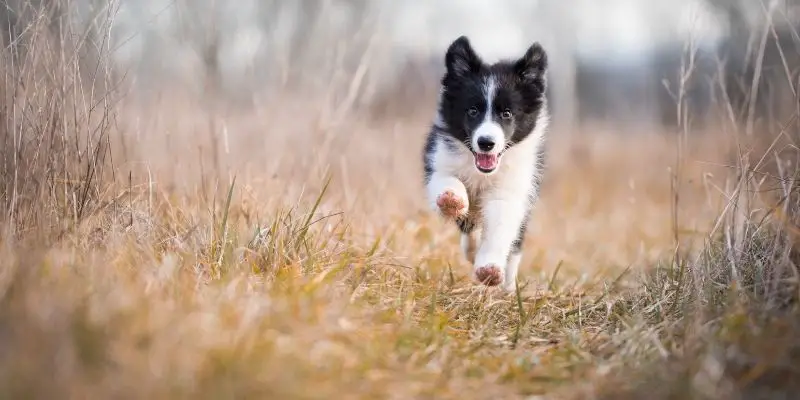
This medium-sized wonderdog is an agricultural success story. Border collies, bred to herd animals, appear to have bottomless gas tanks and will work indefinitely to finish tasks.
The border collie is a dream dog for those who enjoy being outside. He is content to swim, walk, jog, do agility courses, and do other activities as long as he is with his humans.
With that in mind, couch potatoes are not required to apply. However, a border collie needs a lot of exercises every day, or he may become bored and destructive.
Border collies have weatherproof double coats, allowing them to spend time outside easily. He sheds seasonally, but you should brush him a few times per week to keep tangles at bay.
German Shepherd
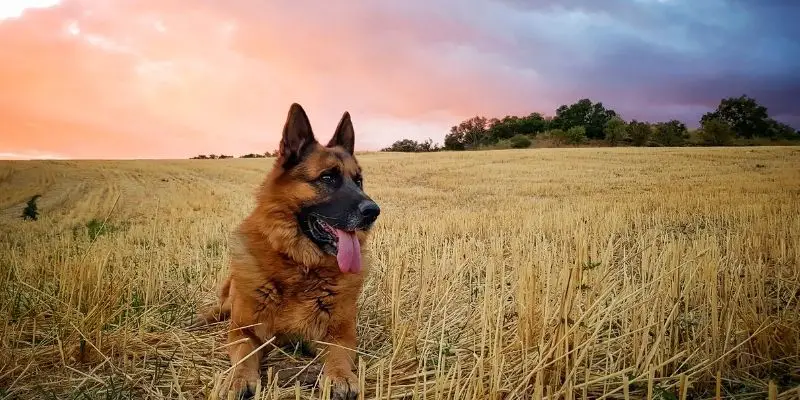
The German shepherd is an all-around worker who enjoys being outside. His athletic character makes him a popular dog breed on the farm and on the trail, and his double coat insulates him when strutting his stuff in chilly weather. Still, he doesn’t get too hot in the summer.
While he is weatherproof, he is not a dog who can be left alone for lengthy periods. He’s what’s known as a Velcro dog since he adores his humans.
In addition to a high-quality diet, the German shepherd needs daily exercise to avoid destructive habits and regular brushing to remove trapped hair from his ever-shedding coat, so make sure you’re up to the effort before bringing one home.
He’s also a highly clever breed with a strong will. Early obedience classes are essential for positively harnessing this, or he will get into mischief.
Great Pyrenees
The Great Pyrenees are protected from the cold by a thick coat. These outdoor dogs, which can weigh up to 130 pounds, are moderately active. Despite their intelligence, Great Pyrenees may be uninterested in dog obedience training. The Great Pyrenees, a hardy mountain dog, was bred to guard and herd cattle in Europe’s Pyrenees Mountains.
Greater Swiss Mountain Dog
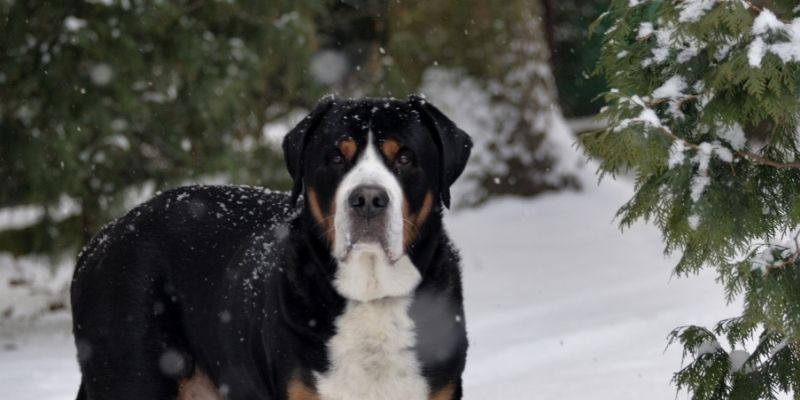
Greater Swiss Mountain Dogs are powerful dogs raised in the Swiss Alps to pull carts and guard cattle. Greater Swiss Mountain dogs are less energetic than other herding dogs, weighing 85 to 140 pounds. Yet, they appreciate being part of in-home activities and having regular exercise. In addition, their short coat allows them to be outside in cool and warm weather.
Irish Wolfhound
The Irish Wolfhound is best recognized for its size, standing over three feet tall, and being one of the world’s tallest canines. These remarkable hunting dogs have a thick, coarse coat and are well accustomed to spending hours, if not days, out in the bush hunting with their owners.
Irish Wolfhounds are not ideal for apartment living or full-time housekeeping due to their size. They may enjoy visiting in the evening to spend time with their families, but this is one breed that is best kept outside.
Labrador Retriever
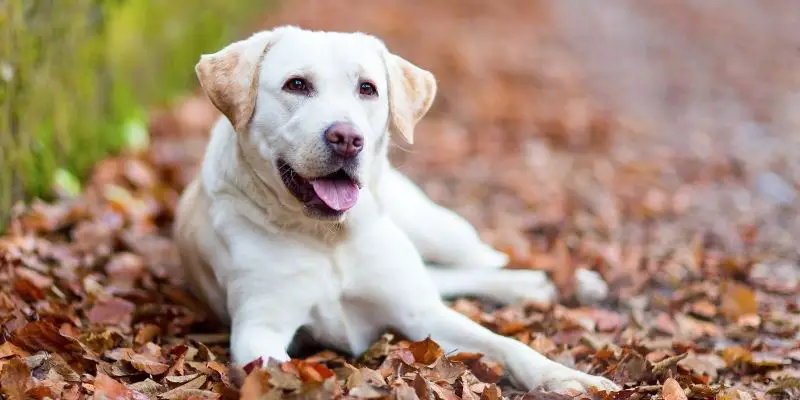
America’s favorite breed has a solid double coat that is slightly water-resistant, making him an ideal outdoor adventure companion.
He can tolerate a little cold but should not be left outside in freezing conditions. He’s a people pleaser at heart and doesn’t mind having some alone time. Still, he shouldn’t be left alone for lengthy periods, or his sensitive spirit will suffer.
Labrador retrievers were created as bird hunting companions and required daily activity to fulfill their insatiable urge to retrieve. Unfortunately, he can also be a heavy shedder, so if you plan on adding one to your furry household, invest in a nice brush.
The Lab is reasonably easy to educate because he is eager to please. Still, he should undergo basic obedience training, especially if you want a well-behaved fur friend.
Mastiff
The Mastiff is a huge and powerful breed with a 5,000-year breed history initially used as a battle dog.
They enjoy spending time indoors with their families but are most at ease outside in nature. However, they can be a little wild and rowdy as puppies, which can be a problem if you keep them inside for too long.
Norwegian Elkhound
The Norwegian elkhound is a stocky hunting dog with a clownish spirit who likes to do things his way. His thick coat functions as a shield against the cold as they were bred to withstand Norwegian winters.
This wooly coat sheds heavily during the season and requires weekly brushing to maintain healthy coat. Unfortunately, it can also cause overheating in hot weather, so don’t let your elkhound outside for long in the summer.
Elkhounds are typically too intelligent for their own good and can be stubborn, so they are not the dog for a beginner. You should begin obedience classes as soon as possible. To keep this bright pup entertained, provide him with activities and toys daily.
Rhodesian Ridgeback
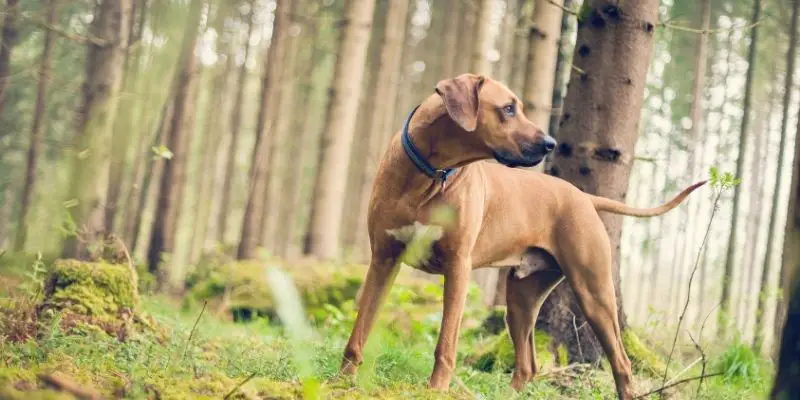
Rhodesian ridgeback may be the ideal partner if you live in a warmer region. He’s a hardy breed that originated in Africa’s savannas and was initially employed for hunting.
His short coat sheds only seldom, so it requires little care. He does, however, require regular exercise to stay fit and happy.
Ridgebacks have intense prey drives and should never be left unattended. He must be properly contained because he will bolt at the sight of a squirrel (or even your neighbor’s Chihuahua).
He’s also a stubborn dog who insists on doing things his way. Because of this, he is not suggested for inexperienced dog owners.
Rottweiler

Despite his huge, boxy form, the Rottweiler is remarkably athletic. The Rottie, a German breed initially designed for cattle farming, is at home outside, whether he’s swimming, running, or on the route.
He has a lot of energy, so daily walks will be a part of your life with a Rottie. He’s also a strong youngster. Therefore obedience courses and frequent socialization are required as a puppy to avoid problems.
Rotties have a double coat that keeps them warm in the winter. It sheds moderately all year (though shedding is highest in the spring and fall) and requires occasional brushing to remove dead hair. While he can withstand the weather, he does not enjoy severe temperatures.
Furthermore, you can’t simply leave a Rottie in the backyard and forget about him. To be happy and the best doggo he can be, he needs to be with his family.
Samoyed
Samoyeds are kind and dedicated to their owners, making them an excellent match for families with children. They were bred in Siberia to pull sleds and guard reindeer. Samoyeds have thick fur that keeps them warm in subzero temperatures. In addition, they are well-known for their wit and friendliness.
Siberian Husky
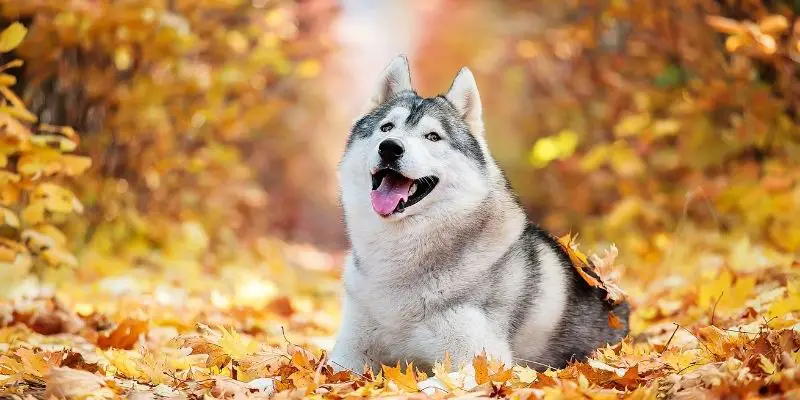
The Siberian husky, like the malamute, thrives in chilly regions. He enjoys the snow and began his career as a sled dog. Because of his inherent need to work, he is one of the most active dog breeds, and he succeeds when given a job that requires both his brain and muscle.
He’s not the type of dog who can spend much of his time alone in the yard without getting into mischief. Instead, he’s a natural for a rally, obedience, and other active dog sports.
The husky’s plush coat is beautiful, but it requires a lot of maintenance. He sheds excessively all year, with two coat-blowing seasons that make a shambles of his surroundings. Purchase a high-quality dog grooming brush!
If you want a husky, start looking into training lessons as soon as possible. While he is a friendly puppy, he can be highly headstrong and far too intelligent for his own good.
Shiba Inu
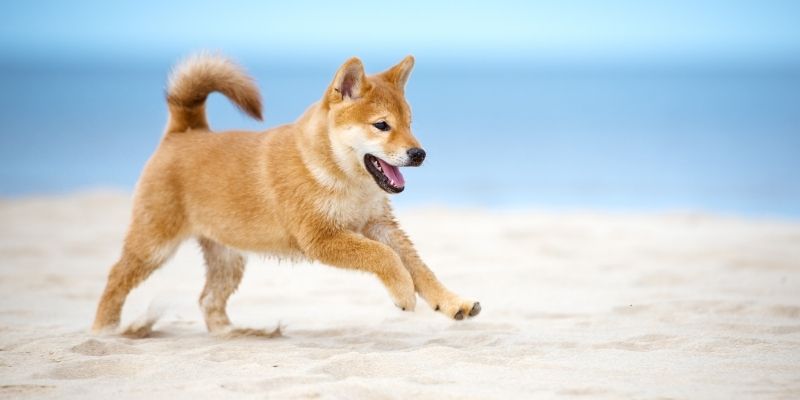
The Shiba Inu is a small to medium-sized Japanese hunting dog developed to flush out small animals and birds.
They are exceedingly gorgeous dogs with a Spitz-like curled tail and a red coat known to have a brave and fiery nature. They are clever, free-thinking dogs who are always attentive and quick on their feet.
Despite their small size, Shiba Inus do not make good inside dogs and are better suited to an active outside life.
Vizsla
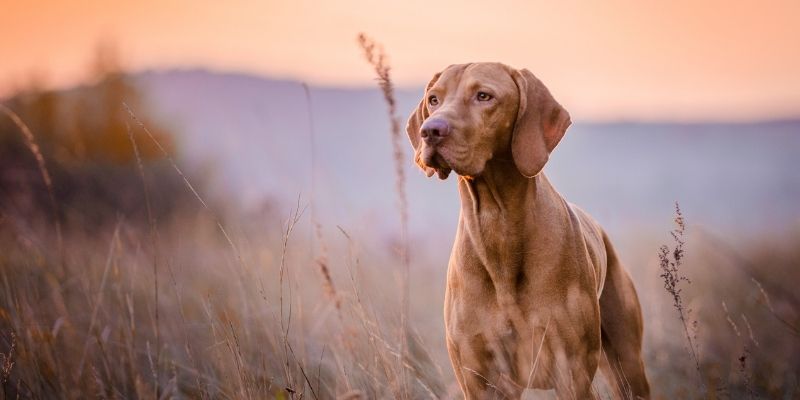
This short-coated Hungarian breed excels in warm climates and was initially bred as a hunting companion.
The vizsla is a natural-born athlete eager to please, making him a fantastic camping and hiking companion.
Because of his amiable personality, he is sensitive, so positive reinforcement training is essential.
Because vizslas and most vizsla mixed breeds lack an undercoat, they require little grooming, but special care should be taken in colder times to keep him warm. His floppy ears also require attention, as they are susceptible to ear infections if not kept clean and dry.
Weimaraner
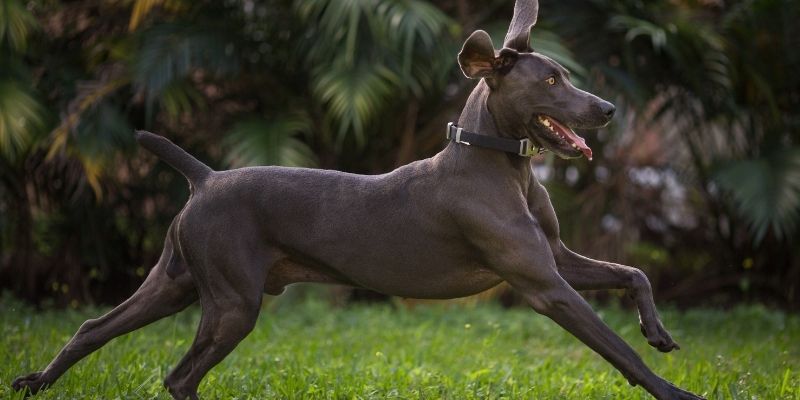
The Weimaraner is a German gun dog who enjoys anything outdoors and is a sporting group favorite because of his distinctive gray coat.
His short coat requires little grooming, and he does not readily overheat in hot weather. However, he is not a winter weather breed and should not be left alone for long periods, whether hot or cold. He enjoys being with his owner and dislikes feeling abandoned.
Weims are all-around athletes, ideal if you enjoy being active and traveling on adventures.
Daily activity, whether jogging around the block with you or flushing game in the field, helps him thrive. He’s also a keen learner, making him easier to teach than most breeds.
Credits: thanks for the cover photo to Canva.

Disclosure: At pawtypooch.com we only mention the products that we’ve researched and considered worthy. But it’s important to note that we are a participant of several affiliate programs, including VigLink, ShareASale, Skimlinks, and Amazon Services LLC Associates Program, an affiliate advertising program designed to provide a mean for us to earn fees by linking to Amazon.com and affiliated sites. As an Amazon Associate pawtypooch.com earns from qualifying purchases. Also, please note that pawtypooch.com does not intend to provide veterinary advice. All published articles are meant for informational purposes only. And this information should not be substituted for professional veterinary consultation.

